Piraeus, Athens and Peloponnese Railways
Piraeus, Athens and Peloponnese Railways or SPAP (Greek: Σιδηρόδρομοι Πειραιώς-Αθηνών-Πελοποννήσου "Siderodromi Pireos Athinon Peloponisou" or Σ.Π.Α.Π. (S.P.A.P.); French: Chemin de fer du Pirée-Athènes-Peloponése[1]) was a Greek railway company founded in 1882, which owned and operated the 1,000 mm (3 ft 3 3⁄8 in) (metre gauge) Piraeus–Patras railway line connecting Piraeus and Athens to Peloponnese. The company was nationalized in 1954 and absorbed by the Hellenic State Railways in 1962.
 | |
| Overview | |
|---|---|
| Locale | Attica, Peloponnese |
| Dates of operation | 1882–1962 |
| Successor | Hellenic State Railways |
| Technical | |
| Track gauge | 1,000mm (3 ft 3 3⁄8 in) |
The name "Spap" originates from the Greek initials of the railway company.[1]
History

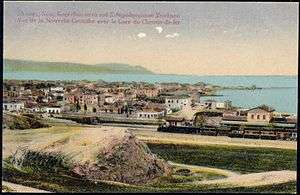
The first line section between Piraeus, Athens and Elefsis was completed in 1884. The line reached Corinth in 1885 and Patras in 1887. In the meantime, an eastern branch from Corinth reached Argos and Nafplion in 1886. The western branch reached Pyrgos and finally Kyparissia in 1902. SPAP also acquired the line between Myloi (near Argos) and Kalamata via Tripoli, from the bankrupt Southern Greece Railways (Sidirodromoi Mesimbrinis Ellados). The two routes to Kalamata, via Patras and via Tripoli, merged at Zevgolatio.
Short branches were also constructed to serve important towns: Argos-Nafplion, Lefktro-Megalopolis, Kavasila-Vartholomio-Kyllini, Vartholomio-Kyllini Spa (Loutra), Pyrgos to Ancient Olympia, Asprochoma-Messini and, much later (1954), Isthmos-Loutraki. Diakofto Kalavrita Railway was also constructed by SPAP, but at a smaller gauge (750 mm or 2 ft 5 1⁄2 in).
The line from Piraeus to Corinth was 99 km, from Corinth to Kalamata via Tripoli 236 km and from Corinth to Zevgolatio via Patras and Pyrgos 347 km. The total length of the system with the branch lines was 731 km.
In 1929 SPAP acquired the Heraklion-Lavrion section of Athens-Lavrion Railway, formerly operated by Attica Railways, and constructed a link from Kato Liossia (today Agioi Anargyroi) to Heraklion, to connect the Lavrion line to its network (1931). Passenger services on this branch were suspended in 1957 and it was cut off from the rest of the network in 1962, due to the construction of the Athens-Thessaloniki highway.
During the Axis occupation of Greece in World War 2, and especially during the withdrawal of German troops in 1944, the network and the rolling stock suffered extensive damages both by the German army and by Greek resistance groups. Repair of SPAP assets was time consuming and expensive. Damaged rolling stock was mainly repaired at Piraeus Engine Sheds. Normal levels of service resumed at about 1948 with the exception of the destroyed bridge of Achladokampos (between Argos and Tripoli), which was rebuilt by OSE in 1974.
In 1951 SPAP absorbed the small Pyrgos-Katakolo Railway. In 1953 SPAP absorbed Northwestern Greece Railways (SDBE), which operated a metre gauge line from Kryoneri to Messolongi and Agrinion.
In 1920 SPAP was briefly nationalized as part of the Hellenic State Railways but it became an independent company again two years later. Due to high debts, SPAP came under government control in 1939-1940 and was formally nationalized again in 1954. In 1962 the company was absorbed by the Hellenic State Railways.[2]
Suspension
The economic crisis in Greece led to the suspension of all passenger and freight services on the metre gauge railway system in the Peloponnese in 2011.
Current situation
It is unlikely services will ever resume as a publicly run system, although some privately-chartered services occasionally run. A short section through the port city of Patras remains open as a suburban railway.
Partial reopening
As part of the P.A.Th.E./P. project, the former section of track between Athens and Kiato has been rebuilt to standard gauge and electrified. The Athens Airport–Patras railway, opened in 2007 until Kiato, is served by Proastiakos Athens suburban trains. In 2019 this line will be extended to Aigio as part of Proastiakos[3] and eventually Patras, providing a double-track standard gauge rail connection between Patras and Athens. An extension from Patras to Kalamata via Pyrgos is also planned.[4]
Rolling stock
Steam locomotives
Between 1883 and 1962 SPAP used 128 locomotives of 25 different types.
| Photo | Class | Numbers | Type | Quantity | Manufacturer | Serial Nos. | Year | Power | Notes |
|---|---|---|---|---|---|---|---|---|---|
 |
Α | 1-4 | 0-4-0T | 4 | Krauss | 1883 | |||
| Α | 5 | 0-4-0T | 1 | Krauss | 1885 | ||||
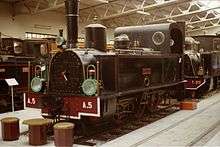 |
Α1-6 | 0-6-0T | 6 | Couillet | 1888 | ||||
| Β | 101-109 | 2-4-0T | 8 | Krauss | 1883 | ||||
| Β | 111–114 | 2-4-0T | 4 | Krauss | 1888 | ||||
| Βς | 151–155 | 2-4-0T | 5 | Henschel | 1912 | ||||
| Γ | 201-205 | 2-6-0T | 5 | Krauss | |||||
| Γ | 261–268 | 2-6-0T | 8 | Couillet | 1890 | Ex Myloi—Kalamata railway, later renumbered 211–218 | |||
| Δ | 251-252 | 2-6-0T | 2 | Krauss | 1886 | rebuilt as 4-6-0T in 1888 | |||
| Δ | 253-254 | 4-6-0T | 2 | Krauss | 1888 | rebuilt as 4-6-0T in 1888 | |||
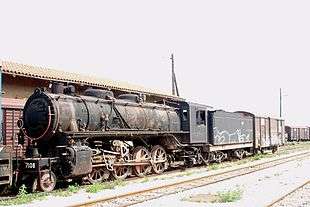 |
Δ (Δα) | 101–108 | 2-8-2 | 8 | Vulcan Iron Works | 1947 | 644 kW (864 hp) | USATC S-118 copies | |
 |
Δ (Δι) | 111–120 | 2-8-2 | 10 | Breda | 1951 | 770 hp (574 kW) | ||
| Ε | 151–152 | 4-4-0T | 2 | Krauss | 1887 | ||||
| Ες | 701–702 | 2-8-0 | 2 | Borsig | 1912 | ||||
| Ες | 711–713 | 2-8-0 | 3 | Borsig | 1914 | ||||
 |
Ες | 721–725 | 2-8-0 | 5 | Linke-Hofmann | 1925 | |||
 |
Ες | 726–728 | 2-8-0 | 3 | Henschel & Sohn | 1936 | |||
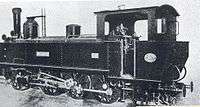 |
Ζ | 500 | 2-6-0T | 1 | Vassiliadis Works | 1900/1929 | |||
| Ζ | 501–517 | 2-6-0T | 17 | SACM Grafenstaden | 1890–1901 | ||||
| Ζ | 518–526 | 2-6-0T | 9 | Krauss | 1902–1906 | ||||
 |
Ζς | 530–533 | 2-6-0T | 4 | Krauss | 1911 | |||
| Ζς | 540–542 | 2-6-0T | 3 | Krauss | 1926 | Ex Attica Railways | |||
| Η | 551–552 | 2-6-0T | 2 | St. Léonard | 1891 | ||||
| Θ | 601–603 | 2-8-0 | 3 | Krauss | |||||
| Ι | 651–660 | 2-4-0T | 10 | Société Belge | 1889 | Ex Myloi—Kalamata railway | |||
| Κ | 701 | 0-6-0T | 1 | Krauss | 1889 | Ex Myloi—Kalamata railway, originality Kalamata Harbour | |||
| Μ | 801–803 | 0-4-4-0 | 3 | Krauss | 1908 | Mallet locomotives | |||
 |
ΔΚ | 1–5 | 0-6-2RT (750 mm (2 ft 5 1⁄2 in)) | 5 | Cail/MPR | 1891/1954 | |||
| ΔΚ | 11 | 0-6-RT (750 mm (2 ft 5 1⁄2 in)) | 1 | Krupp | 1891 | ||||
Diesel multiple units
SPAP introduced diesel railcars and multiple units early in 1937. They reduced journey times and offered good passenger facilities.
| Class | Type | QTY | Manufacturer | Model | Power | Year | Photo |
|---|---|---|---|---|---|---|---|
| ΑΚ210 | Β-2 | 8 | DWF/MAN | 1937 | 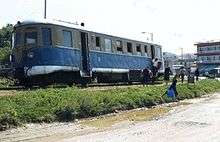 | ||
| 3ΑΚ1000 | B-2-2-B | 7 | Esslingen | 1956–1957 | |||
| 3ΑΚ640 | B-2-2-B | 13 | DeDietrich | 1950–1952 | 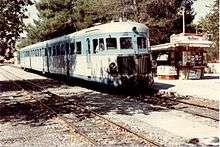 | ||
| 2ΑΚ420 | B-2-B | 8 | Linke-Hofmann | 1937 |  | ||
| ΑΔΚ01 (750mm) | B-B+2+2-2 rack |
3 | Billard | 1958 | |||
| ΑΚ2Χ155 [5] | 1A-A1 | 3 | Breda | 1952 |
Diesel locomotives
| Class | Type | QTY | Manufacturer | Model | Power | Year | Photo |
|---|---|---|---|---|---|---|---|
| DBς320.01 | 1-B | 1 | Piraeus Works | 320 HP | 1961 | ||
See also
- Diakofto Kalavrita Railway
- Athens–Lavrion Railway
Notes and references
- Martin, Percy Falcke. Greece of the Twentieth Century. T. Fisher Unwin, 1913. p. 193. Available at archive.org.
- Law 4246/1962
- "More Suburban Railway Stops Added to Peloponnese Line". GTP News. 18 April 2019.
- "PATRA – PIRGOS – KALAMATA". ErgOSE.gr. 21 March 2018. Retrieved 5 August 2019.
- Ordered by the Northwestern Greece Railways (SDBE)
- Durrant, A. E. (1972) [1966]. The Steam locomotives of Eastern Europe. Newton Abbot, Devon, UK: David and Charles. ISBN 0-7153 4077 8.CS1 maint: ref=harv (link)
Further reading
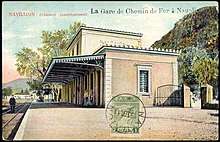
- Organ, J. (2006). Greece Narrow Gauge. Middleton Press. ISBN 1-904474-72-1.CS1 maint: ref=harv (link)
- Schönborn, Hans-Bernhard (1997). Edition Ergasias (ed.). Schmalspurbahnen in Griechenland (Peloponnes und Thessalien) (in German). ISBN 3-909221-32-7.CS1 maint: ref=harv (link)
- Simms, W. F. (1997). The railways of Greece. Wilfried F. Sims. ISBN 0-9528881-1-4.CS1 maint: ref=harv (link)
- J.D.H. Smith, J. D. H. (2011). "Piraeus, Athens and Peloponnese Railways steam locomotives". Retrieved 2011-02-14.
- Voyageur (Anonymous) (February 1941). "The Railways of Greece". The Railway Magazine. London, UK: Railway Publications. 87 (524): 64.CS1 maint: ref=harv (link)
- Winkworth, D. W. (May 1967). "Peloponnese Narrow Gauge". The Railway Magazine. London, UK: Transport & Technical Publications Ltd. 113 (793): 249–254.CS1 maint: ref=harv (link)
- Zartaloudis, I.; Karatolos, D.; Koutelidis, D.; Nathenas, G.; Fasoulas, S.; Filippoupolitis, A. (1997). Οι Ελληνικοί Σιδηρόδρομοι (Hellenic Railways) (in Greek). Μίλητος (Militos). pp. 176–216. ISBN 960-8460-07-7.CS1 maint: ref=harv (link)